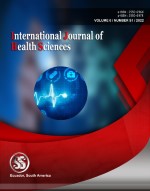A study on renal stones incidence with regard to age, gender and chemical composition of stones in Western Iraq
Keywords:
urinary stones, chemical composition, Calcium oxalate, urateAbstract
This study was done to calculate the incidence of urinary stones in relation to age, gender and chemical composition of urinary stone. Moreover, the study was conducted in the period from the 1st of December 2020 to 1st of December 2021. Hundred patients were included in the study from both sexes, their ages ranged from 24 to 57year whom diagnosed with renal stone. All samples analyzed qualitatively by standard methods. The study showed that renal stones were more in males (80%) than females (20%) with male to female ratio of 4:1 with higher occurrence at the age of 50-57years. The commonest type was the calcium salts (oxalate and non-oxalate). Finally, the researcher concludes that the urinary stones are a common disease in west of Iraq with higher incidence in men than women. The commonest age of occurrence is 50-57 years and the commonest type is calcium oxalate.
Downloads
References
Wang, W. et al. Prevalence of kidney stones in mainland China: A systematic review.
Sci. Rep. 7, 41630; doi: 10.1038/srep41630 (2017).
D.S. Qaader et al. Prevalence and etiology of urinary stones in hospitalized patients in Baghdad. Eastern Mediterranean Health Journal. Vol. 12, No. 6, 2006.
Weaam Awad Kadhim. A Study to Determine the Commonest Type of Renal Stone in Iraqi Patients Admitted to Al_ Hussein General Hospital in Kerbala. Karbala J. Med.Vol.8, No.1, June, 2015.
Wang et al. Distinguishing Characteristics of Idiopathic Calcium
Oxalate Kidney Stone Formers with Low Amounts of
Randall’s Plaque. Clin J Am Soc Nephrol 9: 1757–1763, October, 2014.
Fakhria Jaber Muhbes. Risk factors for renal stone formation: A field study. Health science journal. Volume 6, Issue 4, 2012.
Adnan H. Afaj and Meitham A. Sultan. Mineralogical Composition of the Urinary Stones from Different Provinces in Iraq. The Scientific World Journal (2005) 5, 24–38.
Afaj and Sultan Mineralogical Composition of the Urinary
Stones from Different Provinces in Iraq. The Scientific World Journal.Vol 5, 24–38.20005.
Zainab Ali kadhum. Prevalence Of Urinary Tract Calculi And The Qualitative Analysis Of Their Chemical Composition Of Patients With Urolithiasis In Thi - Qar Governorate / Iraq. Thi-Qar Medical Journal (TQMJ): Vol (6) No (1):2012(90-98).
Pratima Shah el al.Urinary Calculi: A Microbiological and Biochemical Analysis at aTertiary Care Hospital in Eastern Nepal. International Journal of Microbiology.Volume 2020, Article ID 8880403, 9 pages.
Scales Jr et al. Urinary Stone Disease: Advancing Knowledge, Patient
Care, and Population Health. Clin J Am Soc Nephrol 11: 1305–1312, July, 2016.
A. Halin´ ski, K. Hassan Bhatti, L. Boeri, et al. Stone composition of renal stone formers
from different global regions. Archivio Italiano di Urologia e Andrologia 2021; 93, 3.
Ahmet Tefekli1 and Fatin Cezayirli . The History of Urinary Stones: In Parallel with Civilization.TheScientificWorldJournal.Volume 2013, Article ID 423964, 5 pages
Tilahun Alelign 1,2 and Beyene Petros. Kidney Stone Disease: An Update on Current Concepts.AdvancesinUrology.Volume 2018, Article ID 3068365, 12 pages
Shu Wang et al.Upper urinary tract stone compositions: the role of age and gender. nt Braz J Urol. 2020; 46: 70-88.
Victoriano Romero, Haluk Akpinar, Dean G. Assimos. Kidney Stones: A Global Picture of Prevalence, Incidence, and Associated Risk Factors. Reviews in urology; 2010, VOL. 12 NO. 2/3.
Borghi L, Schianchi T, Meschi T, Guerra A, Allegri F, Maggiore U, Novarini A: Comparison of two diets for the prevention of recurrent stones in idiopathic hypercalciuria. N Engl J Med 346: 77–84, 2002
Alberto Trinchieri. Epidemiology of urolithiasis: an update. Clinical Cases in Mineral and Bone Metabolism 2008; 5(2): 101-106.
Kumar, S. (2022). A quest for sustainium (sustainability Premium): review of sustainable bonds. Academy of Accounting and Financial Studies Journal, Vol. 26, no.2, pp. 1-18
Allugunti, V.R. (2019). Diabetes Kaggle Dataset Adequacy Scrutiny using Factor Exploration and Correlation. International Journal of Recent Technology and Engineering, Volume-8, Issue-1S4, pp 1105-1110.
Published
How to Cite
Issue
Section
Copyright (c) 2022 International journal of health sciences

This work is licensed under a Creative Commons Attribution-NonCommercial-NoDerivatives 4.0 International License.
Articles published in the International Journal of Health Sciences (IJHS) are available under Creative Commons Attribution Non-Commercial No Derivatives Licence (CC BY-NC-ND 4.0). Authors retain copyright in their work and grant IJHS right of first publication under CC BY-NC-ND 4.0. Users have the right to read, download, copy, distribute, print, search, or link to the full texts of articles in this journal, and to use them for any other lawful purpose.
Articles published in IJHS can be copied, communicated and shared in their published form for non-commercial purposes provided full attribution is given to the author and the journal. Authors are able to enter into separate, additional contractual arrangements for the non-exclusive distribution of the journal's published version of the work (e.g., post it to an institutional repository or publish it in a book), with an acknowledgment of its initial publication in this journal.
This copyright notice applies to articles published in IJHS volumes 4 onwards. Please read about the copyright notices for previous volumes under Journal History.
















